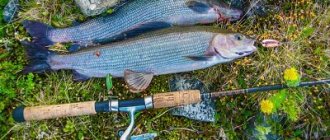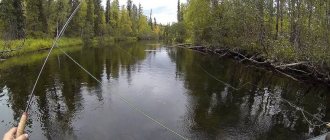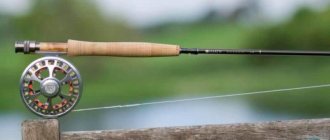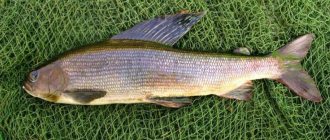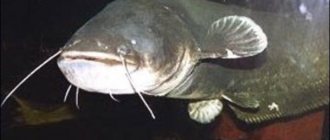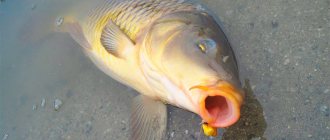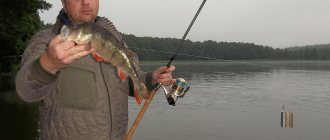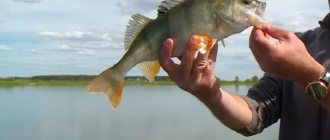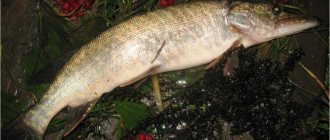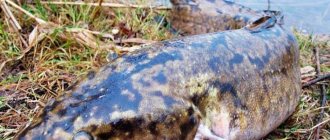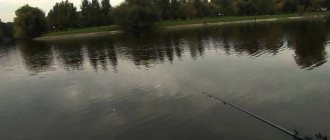A little about grayling
It’s autumn, the leaves are falling, there are heavy rains, it’s time to go mushroom picking, or sit at home and drink hot tea. But not in the case of a fisherman.
A person dedicated to his work will find something to do even in such nasty weather. And today we are going for a beautiful and strong fish, whose fin looks like a sail. Of course, we are talking about grayling.
Grayling inhabits all the northern rivers of our vast country, so we will have to go a long way in search of this beautiful fish. Grayling feeds on the larvae of insects living in rivers, the favorite of which is the caddisfly, and less commonly the stonefly.
To understand what to catch grayling with and what it eats, when catching a fish, you should cut open its stomach. This is exactly what experienced fishermen do.
The peak activity of this fish occurs in the daytime, before the insects fly out. That's when you should start fishing. You can catch it with any gear.
It is successfully caught using a spinning rod or a float rod, but the most effective method is, of course, fly fishing. Fly fishing is a whole science that needs to be understood; such fishing requires endurance and patience and, of course, a certain technique. Well, technology comes with experience, and we go to the Naran River.
Grayling fishing on the Naran River
Here I caught fish weighing 1.5 kilograms, and there were gatherings of larger specimens. I went to this river with an expedition of experienced fishermen; this was not my first time doing this, so there were no difficulties for me.
Rafting on the Naran River was carried out in the fall of 2013 at the beginning of October. I took several sets of gear with me, namely a float rod with rings, 5 meters long, plus a 3.5 meter fly rod and, of course, an ultralight spinning rod.
We first started fishing with light class spinning lures. These were mainly turntables of small numbers, namely No. 1, No. 2, No. 3. Grayling responded well, but still not as well as with fly fishing, which we will talk about later.
The fishing rod also played its role. Everything is simple here, we take a darker float so as not to arouse distrust in the fish and put a suitable fly, there were a lot of cliffs.
On the first day we lost a large number of good flies, but no one was upset, because our team had a fly tying master. Grayling preferred nymphs and wet flies.
Catching grayling with a Tyrolean stick
The Tyrolean stick, also known as the jumper, or ballerina, is a hollow tube with a sinker on one end and a winding ring on the other. The tube is made of an inconspicuous material, since grayling has excellent eyesight and, in case of danger, immediately flees. Its main task is to keep artificial flies directly near the bottom, preventing them from floating up and ensuring play in the current.
Making the equipment is quite simple: a piece of fishing line with a diameter of 0.3 mm is attached on one side to the sinker, and at a distance of 40 cm the first outlet for the leash with the fly is attached. After another 40 cm, the second branch (you can install up to four, but optimally two). We measure out the next 40 cm and knit a loop that will connect to the main fishing line - the tackle is ready.
Fishing will definitely bring good results if you have several equipment of different weights with you (the appropriate one is selected directly at the fishing site) and a reserve in case of breaks. In addition, it is necessary to prepare the maximum possible number of flies. Which ones? Old-timers will best answer this question, so take everything you have.
The cast is made over a considerable distance, almost diagonally. When the sinker “hits” the bottom, a slow reeling begins. In this case, the load is carried downstream and it seems to bounce, forcing the bait to play in the stream. Additionally, you can activate the movement of the flies with the tip of the rod. Only two types of wiring are used: slow, uniform, or twitching. The bite is transmitted directly to the rod blank, but distinguishing it from the sinker touching the stones is a matter of experience.
Float for "balda"
Fly fishing for grayling
It was fly fishing that was most in demand on this trip. I used a light class rod and a fairly soft and thin line.
It was possible to catch fish even more intensely with fly fishing than with a fishing rod or spinning rod. You feel all the wiring with your fingers, so there are few idle bites.
All the fish caught well, and the balanced flexible tackle made it possible to bring fish of decent size to the shore. I fished using a simple method, namely rafting. The point is that you place the bait on the current and carry out a controlled rafting.
Sometimes the bite happened at a considerable distance, and then you had to tinker with the fish, and the strong current only contributed to good resistance.
The large dorsal fin of the grayling acts as a brake. When bitten, the large fin fully opens in the water and makes fishing difficult. With a lightweight fly fishing rod, you get simply unforgettable pleasure.
Flies for fishing grayling
A distinctive feature of dry flies intended for fishing grayling is that they must float on the surface of the water without diving deep, and have impressive plumage. Dry flies for fishing grayling in the fall are kept on the surface of the water thanks to a special water-repellent impregnation.
They fish with such flies using fly fishing tackle or use long telescopic rods.
Wet flies often copy the appearance of the delicious insects that this fish likes to feast on. One of the most popular varieties of such flies are streamers, which look exactly like fish fry. They are equipped with long feathers and are made on hooks with a long shank.
Baits similar to streamers, the so-called bucktails, are equipped with fur or wool plumage. Playfully swaying in the water , they successfully attract grayling.
Flies for catching grayling in the fall are often divided into “riding” and “flooded” models, but in fact they all belong to the category of “wet” flies. However, they serve in different ways - submerged flies float in the water column, and high flies stay just below the surface of the water or drift on it.
Fishing with a submerged or riding fly? The question is interesting, but they solve it based on weather conditions and the characteristics of the reservoir.
Important factors are also the time of year, morning outside, afternoon or evening. The behavior of grayling also helps to make a decision - if the fish feeds from the surface, accompanying its stay with sonorous splashes and water splashes, then the choice must be made in favor of a riding fly.
Fishing with it is especially successful after lunch and in the late afternoon. But in windy weather , and especially in autumn, grayling prefers submerged flies.
https://youtu.be/kWRTyC4HTzQ
What to use to catch grayling in the fall?
When fishing for grayling in the fall, it is preferable to fish with dark and even dull flies. Don't pass by gray and even black colors. It is excellently caught on green ones, which imitate the larva of a caddisfly, which grayling loves so much.
Wet flies also work, but not as well as stonefly and caddis imitations. The grayling did not react to butterflies and dragonflies, since it was not the season for such fishing. But once again, the caddisfly comes first.
Streamers work the same way, but the main thing here is not to make a mistake with the size of the streamer, sometimes every millimeter plays a role.
On this trip we had the opportunity to fish with flies tied with our own hands. And the local huntsman showed a fly tied on a carp hook, citing the fact that it was easier to catch the fish this way, and there were fewer catches.
We did just that, tied a dozen of these flies overnight, and the result not only met all expectations, but shocked some. It’s good if the fish went 1 out of 10.
Lure fishing
In autumn, you cannot find a more catchy bait than a spinner. Catching grayling in the fall with a spinner will be better with petal-type models than with oscillating baits. The optimal length of the spinner falls within the range from 15 to 30 mm.
After the spinner has done its job, the soft-lipped grayling will actively strive to be released, and the main thing here is careful fishing, otherwise the soft tissues of the fish will tear and a breakdown will follow. There is no need to make too sudden movements , and there is no need to lead the fish too quickly.
The main indicator of the quality of a spinner is the high degree of mobility of the petal. If the lure is equipped with an additional sinker head, it should be avoided.
As for the color of the spinners, you need to remember an important rule - the cloudier the water, the more contrasting the shade of the bait should be.
Yellow and silver shades have good catchability ; spotted and striped spoons of black and red colors have also proven themselves well. Experienced fishermen advise decorating a sharpened hook with colored wool threads or pieces of New Year's tinsel.
Grayling fishing line
If you want to catch grayling, then you should exclude braided line from your arsenal, as it is very scared of this type of fishing line. The braid is clearly visible in the water and this reduces the number of bites significantly.
Of course, fluorocarbon is not in competition, and this is not even stated. I think everyone who knows about fishing knows why.
It was fluorocarbon that I used as a fly fishing leader. Thanks to this I caught a lot of tails.
How to catch grayling?
In the fall, grayling leaves its usual course and slides into deep places where it can wait out the cold. But the most interesting thing is that he practically doesn’t bite here, and here’s why.
At midday, grayling comes out to feed in shallow water. Since he has already changed his place on the river, replacing his summer stop with an autumn one, he should be looked for at the exit from the pit. It is in this place that grayling actively feeds. Our task is to correctly present the bait to the fish.
To save energy, grayling settles in quiet backwaters. Here you should use a completely different fishing technique. You should choose a spinning rod as your main gear.
Why spinning, it's very simple. Since the bait, namely a rotating spoon, reaches the bottom, where the grayling actually stands, it is capable of provoking it to attack.
It is in such places that it is worth using deep-sea bait models; often the handsome grayling reacts to falling baits. Here you should use sinking minnow wobblers.
Wobblers, crankbaits and minnows perform well, and less often shad. The best bait will be a spinner with a weighted core, and the red color of the petal is a classic.
Successful grayling fishing on the Naran River is more likely in places with washed out banks, called balconies. In such balconies there are the largest fish, less often small fish, well, strangely enough, we didn’t come across small fish at all.
On large Siberian rivers, such as the Naran, the best tactic is to constantly search for fish and catch not only the coastal zone, but also the opposite bank, if of course this is possible.
In the center, the fish stand less often, so it is the coastal edge that attracts all the angler’s attention. In this place, the bait should be applied slowly, so as to provoke the fish to attack.
The next tactic is to completely fish a promising point. It is used when grayling is less active and then it makes sense to stay longer at the point; by and large, this tactic brings results.
This is how our trip to the glorious Naran River went, where there was a lot of new and interesting things for me and my friends. Of course, I gained a lot of experience in catching this fish and not just experience, but experience in catching grayling.
How to catch grayling in the fall using a float
This method is the simplest and most convenient. No major financial outlay or fishing experience is required. However, at the beginning of the season, not only novice anglers use a float rod. If fishing is planned on a small river, heavily overgrown along the banks, even professionals will choose a fishing rod.
The fishing rod is useful for fishing in narrow areas and small riffles. Also where the river narrows and leaves a deep reach.
Note that at the beginning of autumn, grayling lingers in such areas of the water area, since this is where the largest amount of food brought by the current will be.
Choosing a fishing rod
When fishing with a fly rod, casting is limited by the length of the equipment and the stick itself.
The fly rod allows you to set up sensitive equipment for the capricious grayling. A limited casting distance will produce mostly small fish.
From the classic equipment of a float rod, the equipment for catching grayling may also differ, and significantly. Experienced fishermen do not use a separate hook and weight, but tie a jig to the leash. There is another way to increase the sensitivity of a float rod rig. It consists of using two leashes: a jig is fixed on the lower one, and hook No. 3-4 is fixed on the upper leash. Such a fishing rod rig will allow you to “probe” grayling in different layers of water.
Quite often, floats are not used; they are caught in the wire using a grasshopper or a fly. If natural insects are no longer available, artificial flies are placed. With a float they fish for a worm, less often maggots or bloodworms. Grayling bites well in the fall on caddis flies, which can be caught right on the river.
We recommend reading: Burbot fishing in February
Equipment
- The float is made of foam plastic or goose feather; you should not use bright shades of colors when decorating;
- Hook with a short shank and a straight point No. 3-4, preferably dark in color;
- Fluorocarbon fishing line, diameter in the range of 0.15-0.2 mm. It is necessary to use fluorocarbon due to the transparency of cold water, in which ordinary nylon will be more noticeable;
- Rod length is 3.1-6 meters (the choice depends on the size of the river where you plan to fish);
- If a weight is used, it is recommended to move it closer to the float, which will allow the bait to float in the water column.
If the mounted tackle meets the listed requirements, then we can speak with confidence about its reliability and efficiency, and most importantly sensitivity, which will allow timely detection of the bite of this wary fish.
